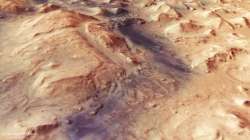ESA's Mars Express sends new images of Martian landscape
The region, a furrowed, rock-filled escarpment known as Nili Fossae sits at the boundary of the northern and southern hemisphere.

The European Space Agency's (ESA) Mars Express has imaged a part of the Martian landscape, a region at the boundary of the northern and southern hemisphere which is rocky and fragmented, that once formed the Red Planet's flood plains.
The region, a furrowed, rock-filled escarpment known as Nili Fossae sits at the boundary of the northern and southern hemisphere.
It is an impressive example of past activity on the planet and shows signs of where flowing wind, water and ice once moved material from place to place, carving out distinctive patterns and land forms as it did so, the ESA said in a statement on Wednesday.
Despite Mars' reputation as a dry, arid world today, water is believed to have played a key role in sculpting Nili Fossae via ongoing erosion.
Nili Fossae is filled with rocky valleys, small hills, and clusters of flat-topped land forms (known as mesas in geological terms), with some chunks of crustal rock appearing to be depressed down into the surface creating a number of ditch-like features known as graben, the ESA noted.
Further, the image also showed the higher-altitude terrain of Nili Fossae. This appears to consist mostly of rocky plateaus while the lower terrain comprises of smaller rocks, mesas, hills and more, with the two sections roughly separated by erosion channels and valleys.
The shapes and structures scattered throughout this image are thought to have been shaped over time by flows of not only water and ice, but also wind, ESA said.
The images showed patches of the surface that appear to be notably dark against the ochre background, as if smudged with charcoal or ink.
These are areas of darker volcanic sand, which have been transported and deposited by present-day martian winds. Wind moves sand and dust around often on Mars' surface, creating rippling dune fields across the planet and forming multi-coloured, patchy terrain like Nili Fossae, the researchers said.
The data comprising this image was gathered by Mars Express' High Resolution Stereo Camera (HRSC) on February 26.